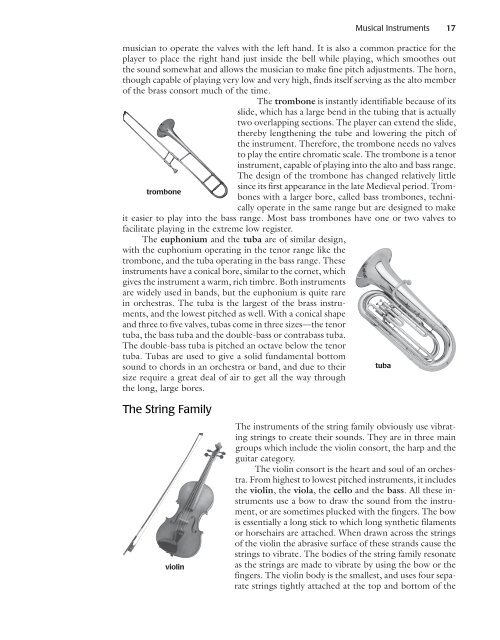Composer Profile - Activefolio
Composer Profile - Activefolio
Composer Profile - Activefolio
Create successful ePaper yourself
Turn your PDF publications into a flip-book with our unique Google optimized e-Paper software.
Musical Instruments 17<br />
musician to operate the valves with the left hand. It is also a common practice for the<br />
player to place the right hand just inside the bell while playing, which smoothes out<br />
the sound somewhat and allows the musician to make fine pitch adjustments. The horn,<br />
though capable of playing very low and very high, finds itself serving as the alto member<br />
of the brass consort much of the time.<br />
The trombone is instantly identifiable because of its<br />
slide, which has a large bend in the tubing that is actually<br />
two overlapping sections. The player can extend the slide,<br />
thereby lengthening the tube and lowering the pitch of<br />
the instrument. Therefore, the trombone needs no valves<br />
to play the entire chromatic scale. The trombone is a tenor<br />
instrument, capable of playing into the alto and bass range.<br />
The design of the trombone has changed relatively little<br />
trombone<br />
since its first appearance in the late Medieval period. Trombones<br />
with a larger bore, called bass trombones, technically<br />
operate in the same range but are designed to make<br />
it easier to play into the bass range. Most bass trombones have one or two valves to<br />
facilitate playing in the extreme low register.<br />
The euphonium and the tuba are of similar design,<br />
with the euphonium operating in the tenor range like the<br />
trombone, and the tuba operating in the bass range. These<br />
instruments have a conical bore, similar to the cornet, which<br />
gives the instrument a warm, rich timbre. Both instruments<br />
are widely used in bands, but the euphonium is quite rare<br />
in orchestras. The tuba is the largest of the brass instruments,<br />
and the lowest pitched as well. With a conical shape<br />
and three to five valves, tubas come in three sizes—the tenor<br />
tuba, the bass tuba and the double-bass or contrabass tuba.<br />
The double-bass tuba is pitched an octave below the tenor<br />
tuba. Tubas are used to give a solid fundamental bottom<br />
sound to chords in an orchestra or band, and due to their<br />
size require a great deal of air to get all the way through<br />
the long, large bores.<br />
The String Family<br />
violin<br />
tuba<br />
The instruments of the string family obviously use vibrating<br />
strings to create their sounds. They are in three main<br />
groups which include the violin consort, the harp and the<br />
guitar category.<br />
The violin consort is the heart and soul of an orchestra.<br />
From highest to lowest pitched instruments, it includes<br />
the violin, the viola, the cello and the bass. All these instruments<br />
use a bow to draw the sound from the instrument,<br />
or are sometimes plucked with the fingers. The bow<br />
is essentially a long stick to which long synthetic filaments<br />
or horsehairs are attached. When drawn across the strings<br />
of the violin the abrasive surface of these strands cause the<br />
strings to vibrate. The bodies of the string family resonate<br />
as the strings are made to vibrate by using the bow or the<br />
fingers. The violin body is the smallest, and uses four separate<br />
strings tightly attached at the top and bottom of the



